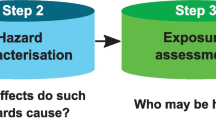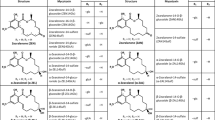Abstract
Ochratoxin A (OTA) is an important food and feed contaminant with potential adverse effects in humans and animals. In view of present discussions on limit values for OTA in foods, essential elements of a toxicological risk assessment are outlined. The exposure situation in Europe is now well documented. The data base, with respect to a characterization of hazard and dose-response relationships, allowed to calculate a provisional tolerable daily intake for OTA suited to protect the consumer against undesirable toxic effects. Nonetheless, further research on OTA is indicated in view of unresolved issues regarding the following points:
-
1.
mechanisms of action (mode of genotoxicity, role of bioactivation/metabolism, identification of DNA-adducts and dose-dependency);
-
2.
combinations of OTA and other mycotoxins (studies of relevant mixtures/conditions);
-
3.
individual susceptibility and/or situation-based vulnerability.
Better information on mechanistic aspects of mycotoxin-induced toxicities will further improve our knowledge on the “margin of safety” between a given exposure and a potential impairment of human health.
Similar content being viewed by others
Literaturverzeichnis
Weber R (1999) Festsetzung von Höchstmengen für Mykotoxine in der EU. In: Proceedings des 21. Mykotoxin-Workshop Jena, pp. 153–155
IARC Monographs on the Evaluation of Carcinogenic Risks to Humans (1993) Volume 56, International Agency for Research on Cancer, Lyon, pp. 489–521
Tatu CA, Orem WH, Finkelman RB, Feder GL (1998) The etiology of Balkan endemic nephropathy: still more questions than answers. Environm Health Perspect 106: 689–700
Wolff J, Bresch H, Cholmakow-Bodechtel C, Engel G, Erhardt S, Gareis M, Majerus P, Rosner H, Scheuer R (2000) Belastung des Verbrauchers und der Lebensmittel mit Ochratoxin A. Abschlussbericht (Teilaspekte der vom BMG geförderten Studie wurden beim 21. Mykotoxin-Workshop in Jena vorgestellt; vgl. Proceedings)
Fuchs R, Hult K (1992) Ochratoxin A in blood and its pharmacokinetic properties. Food Chem Toxicol 30: 201–204
Galtier P (1992) Pharmacokinetics of ochratoxin A in animals. IARC Sci Publ 115:187–200
Kuiper-Goodman T, Scott PM (1989) Risk assessment of the mycotoxin ochratoxin A. Biomed Environm Sci 2: 179–248
Pohland AE, Nesheim S, Friedman L (1992) Ochratoxin A: a review. Pure & Appl Chem 64: 1029–1046
Kuiper-Goodman T (1996) Risk assessment of ochratoxin A: an update. Food Addit Contam 13, Suppl.: 53–57
Hohler D (1998) Ochratoxin A in food and feed: occurrence, legislation and mode of action. Z Ernährungswiss 37: 2–12
Dirheimer G (1998) Recent advances in the genotoxicity of mycotoxins. Rev Med Vet 149, 605–616
Gillman IG, Clark TN, Manderville RA (1999) Oxidation of ochratoxin A by an Fe-porphyrin system: model for enzymatic activation and DNA cleavage. Chem Res Toxicol 12:1066–1076
Obrecht-Pflumio S, Chassat T, Dirheimer G, Marzin D (1999) Genotoxicity of ochratoxin A by Salmonella mutagenicity test after bioactivation by mouse kidney microsomes. Mutat Res 446:95–102
Castegnaro M, Mohr U, Pfohl-Leszkowicz A, Esteve J, Steinmann J, Tillmann T, Michelon J, Bartsch H (1998) Sex- and strain-specific induction of renal tumors by ochratoxin A in rats correlates with DNA adduction. Int J Cancer 77: 70–75
Degen, G.H. (1999) Mycotoxins: research needs. In: WHO Consultation on Current Issues in Risk Assessment of Potentially Toxic Substances in Food of Animal Origin, December 6.–9. 1998, Hannover, Germany. Consensus Report published by the WHO Collaborating Centre for Research and training in Veterinary Public Health, Hannover, Germany, pp. 81–82
Fink-Gremmels J (1999) Mycotoxins: their implications for human and animal health. Vet Q 21: 115–120
Neumann HG, Thielmann HW, Gelbke HP, Greim H, Kappus H, Norpoth KH, Reuter U, Vamvakas S, Wardenbach P, Wichmann HE (1997) Vorschläge zur Änderung der Einstufung krebserzeugender Arbeitsstoffe. Arbeitsmed Sozialmed Umweltmed 32: 298–304
Müller G, Kielstein P, Rosner H, Berndt A, Heller M, Köhler H (1999) Studies on the influence of combined administration of ochratoxin A, fumonisin B1, deoxynivalenol and T2 toxin on immune and defence reactions in weaner pigs. Mycoses 42:485–493
Dörrenhaus A, Flieger A, Golka K, Albrecht M, Degen GH, Föllmann W (2000) Induction of unscheduled DNA synthesis in primary human urothelial cells by the mycotoxin ochratoxin A. Toxicol Sci 53: 271–277
Di Paolo N, Guarnieri A, Loi F, Sacchi G, Mangiarotti AM, DiPaolo M (1993) Acute renal failure from inhalation of mycotoxins. Nephron 64: 621–625
Hallier E, Bünger J, Bolt HM (2000) Tumorerkrankungsrisiken durch Mikroorganismen am Arbeitsplatz. Abschlussbericht Forschungsvorhaben F 1498, BAuA, Dortmund (im Druck)
Author information
Authors and Affiliations
Corresponding author
Rights and permissions
About this article
Cite this article
Degen, G.H. Toxikologische Bewertung von Ochratoxin A: Offene Fragen und Forschungsbedarf. Mycotox Res 16 (Suppl 1), 117–122 (2000). https://doi.org/10.1007/BF02942997
Issue Date:
DOI: https://doi.org/10.1007/BF02942997




